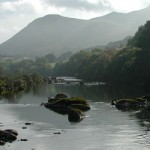Canada is home to 18 UNESCO-designated biosphere reserves, situated across the Atlantic and Pacific coasts in eight provinces and the Northwest Territories – all with varying geography, climate and culture diversity that demonstrate the country’s vast personality.
Canada’s biosphere reserves
The first reserve – Mont St. Hilaire in Quebec – was established in 1978, with the most recent – Tsa Tué BR in the Northwest Territories – designated in 2016. All 18 are special places that model solutions for a sustainable future, celebrate cultural and biological diversity, and empower people to engage with nature intimately and holistically. At biospheres across the country, experiential adventures and immersive accommodations offer visitors a tantalizing taste of the region:
One of the most thrilling experiences in the magical Fundy Biosphere Reserve is witnessing the temperamental tides in the Bay of Fundy. From the park, visitors can see the dramatic effects of the tides on the shoreline and local weather, with the difference between high and low tide as much as 12 metres. When the massive tides recede, they leave behind a vast intertidal zone – endless mudflats where a wide variety of sea creatures make their home. Here, visitors can pull on rubber boots and pick their way through fields of mud, sand and seaweed to discover barnacles, rock crabs, dog whelk sea snails, limpets, periwinkles and other crustaceans – some of the hardiest sea creatures on earth. Current projects here include gathering and analyzing data on how the climate has evolved, and exploring how changes will impact Atlantic Canada as it continues to change.
Trout Point Lodge is a quintessential luxury wilderness lodge in the Tobeatic Wilderness Area, situated in the heart of UNESCO Southwest Nova Biosphere Reserve. Canada’s only member of Small Luxury Hotels of the World, the lodge is also the world’s first certified Starlight Hotel by the UNESCO partner Starlight Foundation. Guests come here for guided stargazing and ecotourism vacations in a secluded location, where sustainable tourism practices are championed and implemented in meaningful policies and practices. Programs include an immersive forest bathing experience in the Acadian Forest, where guests stimulate their senses with a slow, mindful walk in the woods; and nightly stargazing excursions led by the staff astronomer, as well as astrophotography workshops and solar gazing during the day.
The glamourous tent camps from the film Out of Africa inspired the design of Clayoquot Wilderness Resort, a Canadian Signature Experience situated in the Clayoquot Sound Biosphere Reserve in BC. Accessible by floatplane (45 mins from Vancouver) or 30-minute water taxi from Tofino, the resort has become one of the most sought-after wilderness retreats in the world, epitomizing the glamping experience in North America. It features 25 canvas prospector-style tents, each richly appointed with luxurious comforts like cast-iron stoves, ensuite bathrooms with heated floors, private outdoor showers, antique furnishings and luxurious linens. Featured activities include fishing, whale watching, horseback riding, hiking and kayaking, as well as opportunities to meet local Indigenous communities whose stories of the ancient rainforest have inspired one of the strongest conservation movements in Canada. In the surrounding reserve, the Clayoquot Biosphere Trust has implemented several sustainability and cultural initiatives, including Eat West Coast, a regional food security initiative that helps communities and organizations develop effective, community-based responses to food-access challenges and increase understanding of healthy, affordable food choices.
The Beaver Hills Biosphere in Alberta is home to boreal forest and parkland, wildlife, lakes and streams, and several federal and provincial protected areas. One of these is Elk Island National Park, part of the Beaver Hills Dark Sky Preserve – one of the best places in the country to stargaze. Visitors can escape to this protected land and learn about the constellations while cozying up to a campfire, with winter bringing guided Snowshoe and Stargaze events. Indeed, sustainable- and nature-based tourism is a hallmark of the Beaver Hills Biosphere, with several opportunities to engage in Indigenous tourism, agri-tourism and adventure tourism.





Leave a Reply